Suitability Approach in Behavioural Change
VerifiedAdded on 2022/10/31
|11
|3068
|377
AI Summary
This assignment discusses the suitability of administering operant conditioning methods to manage behaviour in the classroom. It begins with observing the range of behaviours typically displayed by 13 and 14-year-olds in a classroom environment and then evaluates a variety of techniques under operant conditioning that could be applied to manage such behaviour. The observed behaviours are analysed and justified under certain key developmental theories. The assignment also discusses the strengths and weaknesses of operant conditioning and its suitability in managing behaviour in the classroom.
Contribute Materials
Your contribution can guide someone’s learning journey. Share your
documents today.
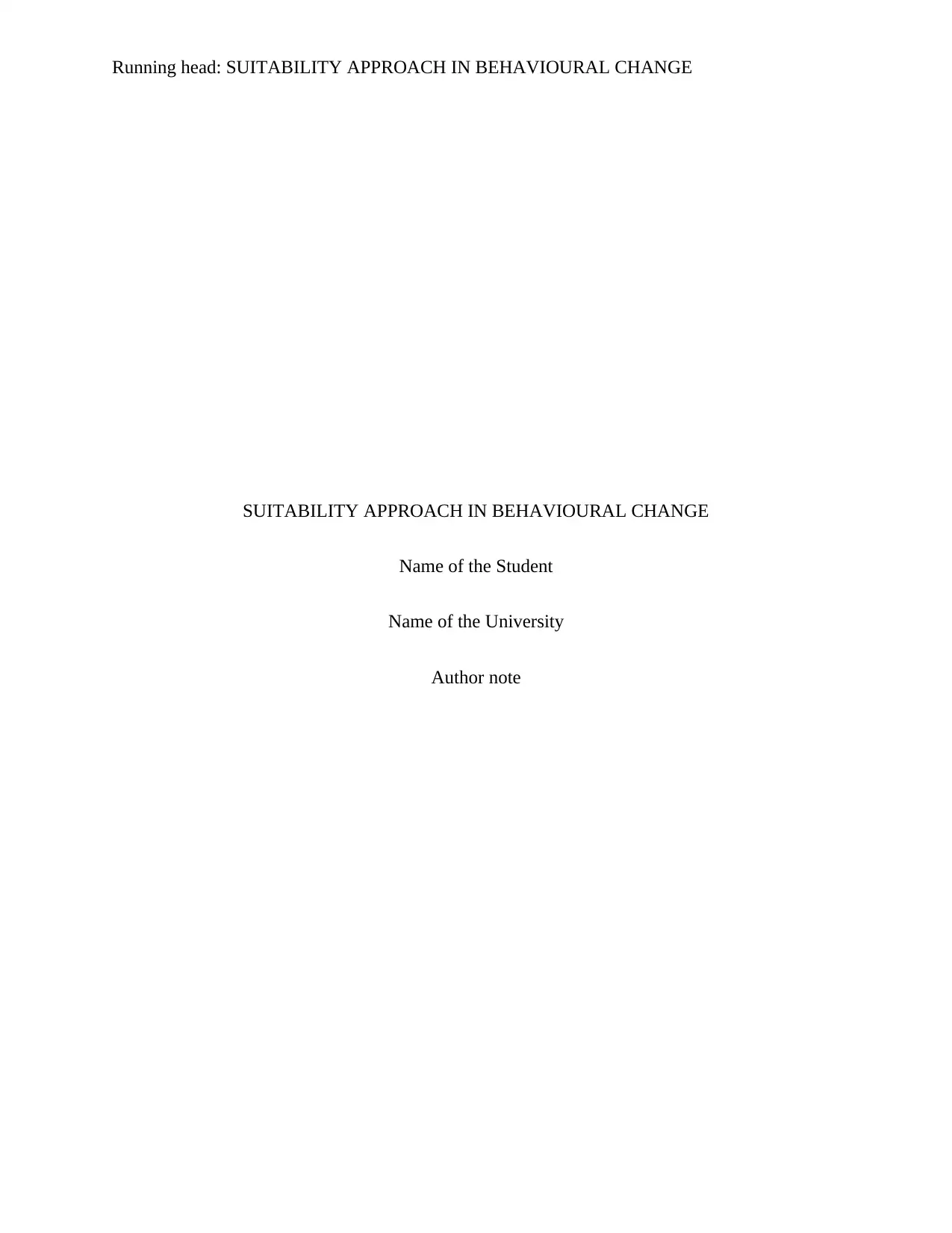
Running head: SUITABILITY APPROACH IN BEHAVIOURAL CHANGE
SUITABILITY APPROACH IN BEHAVIOURAL CHANGE
Name of the Student
Name of the University
Author note
SUITABILITY APPROACH IN BEHAVIOURAL CHANGE
Name of the Student
Name of the University
Author note
Secure Best Marks with AI Grader
Need help grading? Try our AI Grader for instant feedback on your assignments.
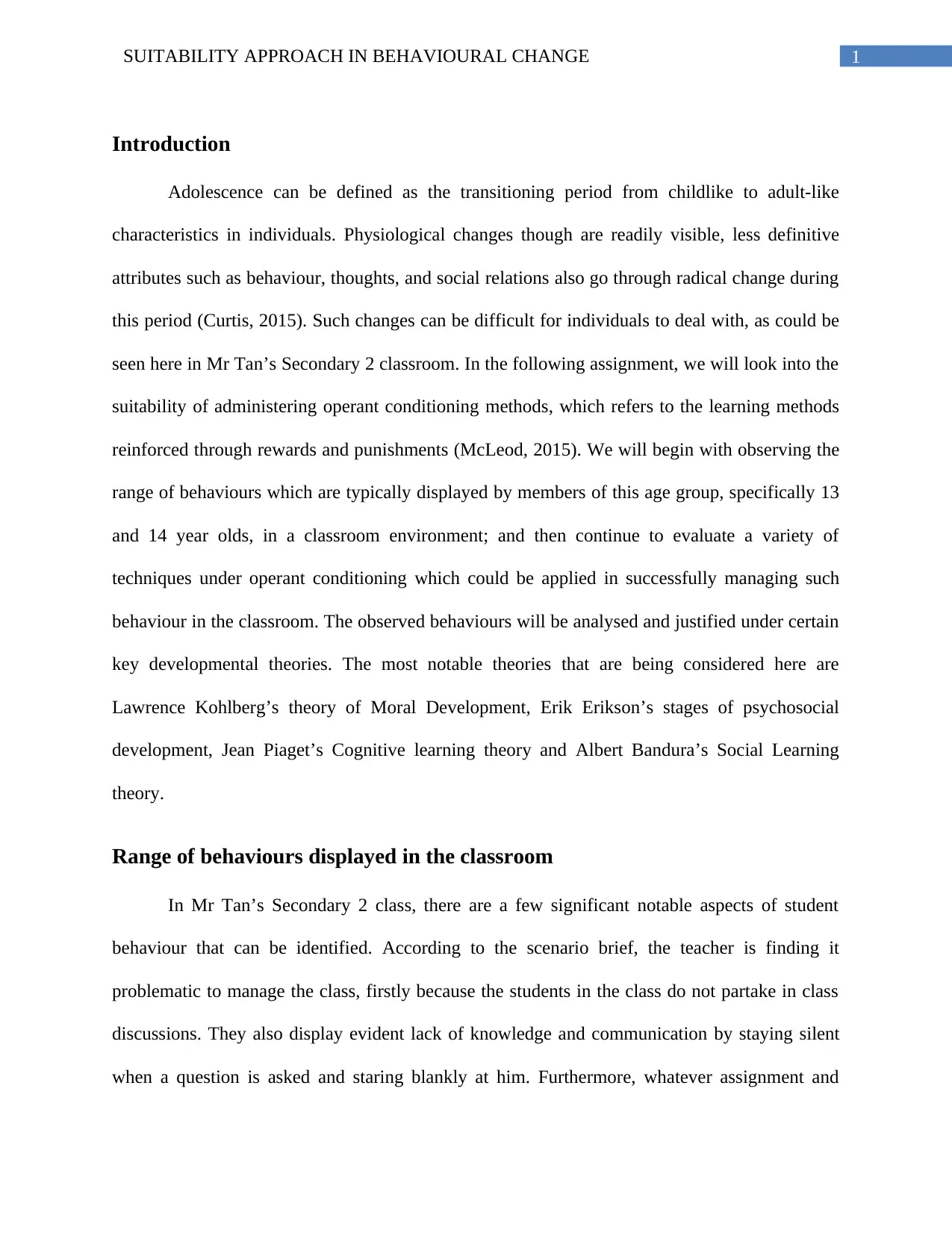
1SUITABILITY APPROACH IN BEHAVIOURAL CHANGE
Introduction
Adolescence can be defined as the transitioning period from childlike to adult-like
characteristics in individuals. Physiological changes though are readily visible, less definitive
attributes such as behaviour, thoughts, and social relations also go through radical change during
this period (Curtis, 2015). Such changes can be difficult for individuals to deal with, as could be
seen here in Mr Tan’s Secondary 2 classroom. In the following assignment, we will look into the
suitability of administering operant conditioning methods, which refers to the learning methods
reinforced through rewards and punishments (McLeod, 2015). We will begin with observing the
range of behaviours which are typically displayed by members of this age group, specifically 13
and 14 year olds, in a classroom environment; and then continue to evaluate a variety of
techniques under operant conditioning which could be applied in successfully managing such
behaviour in the classroom. The observed behaviours will be analysed and justified under certain
key developmental theories. The most notable theories that are being considered here are
Lawrence Kohlberg’s theory of Moral Development, Erik Erikson’s stages of psychosocial
development, Jean Piaget’s Cognitive learning theory and Albert Bandura’s Social Learning
theory.
Range of behaviours displayed in the classroom
In Mr Tan’s Secondary 2 class, there are a few significant notable aspects of student
behaviour that can be identified. According to the scenario brief, the teacher is finding it
problematic to manage the class, firstly because the students in the class do not partake in class
discussions. They also display evident lack of knowledge and communication by staying silent
when a question is asked and staring blankly at him. Furthermore, whatever assignment and
Introduction
Adolescence can be defined as the transitioning period from childlike to adult-like
characteristics in individuals. Physiological changes though are readily visible, less definitive
attributes such as behaviour, thoughts, and social relations also go through radical change during
this period (Curtis, 2015). Such changes can be difficult for individuals to deal with, as could be
seen here in Mr Tan’s Secondary 2 classroom. In the following assignment, we will look into the
suitability of administering operant conditioning methods, which refers to the learning methods
reinforced through rewards and punishments (McLeod, 2015). We will begin with observing the
range of behaviours which are typically displayed by members of this age group, specifically 13
and 14 year olds, in a classroom environment; and then continue to evaluate a variety of
techniques under operant conditioning which could be applied in successfully managing such
behaviour in the classroom. The observed behaviours will be analysed and justified under certain
key developmental theories. The most notable theories that are being considered here are
Lawrence Kohlberg’s theory of Moral Development, Erik Erikson’s stages of psychosocial
development, Jean Piaget’s Cognitive learning theory and Albert Bandura’s Social Learning
theory.
Range of behaviours displayed in the classroom
In Mr Tan’s Secondary 2 class, there are a few significant notable aspects of student
behaviour that can be identified. According to the scenario brief, the teacher is finding it
problematic to manage the class, firstly because the students in the class do not partake in class
discussions. They also display evident lack of knowledge and communication by staying silent
when a question is asked and staring blankly at him. Furthermore, whatever assignment and
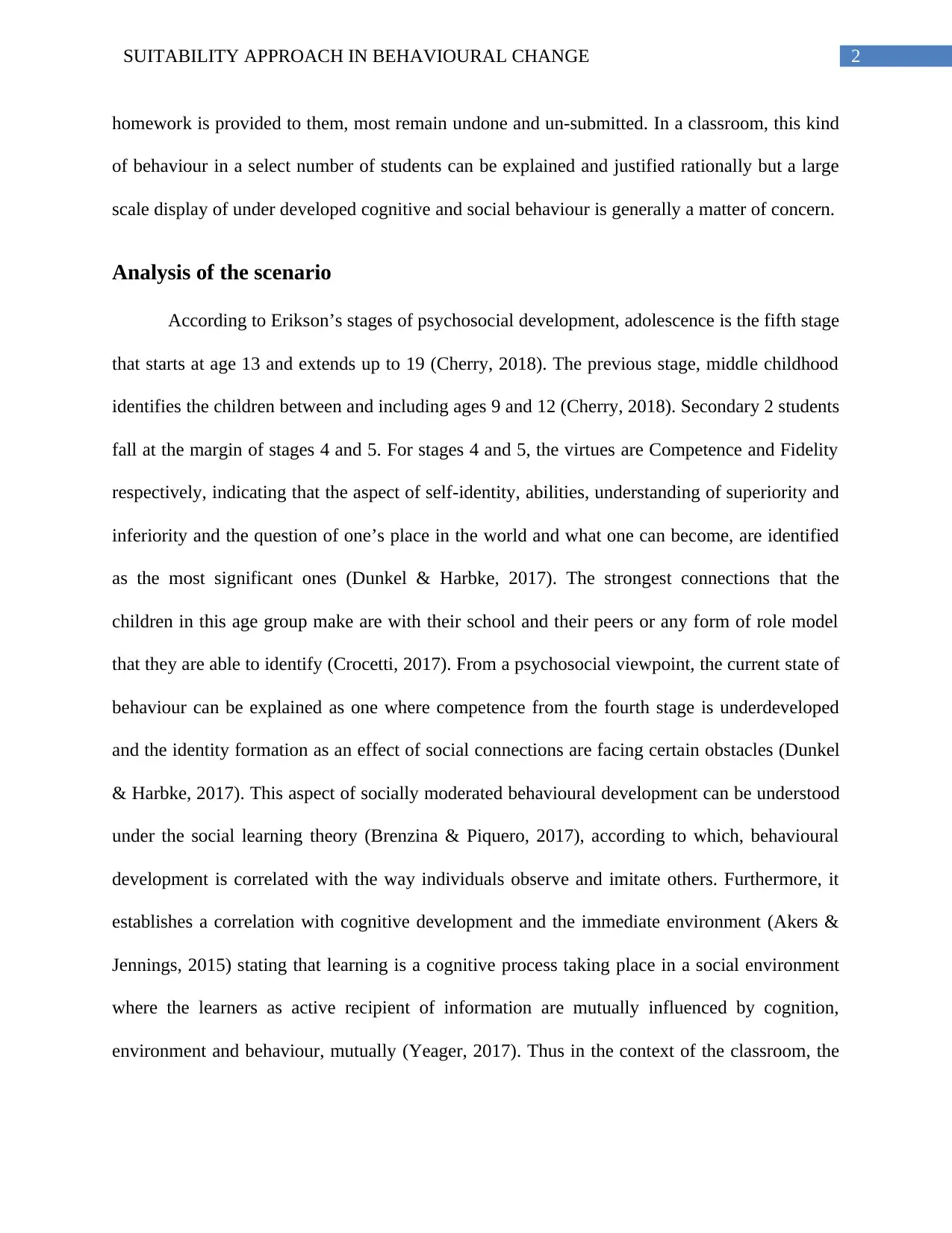
2SUITABILITY APPROACH IN BEHAVIOURAL CHANGE
homework is provided to them, most remain undone and un-submitted. In a classroom, this kind
of behaviour in a select number of students can be explained and justified rationally but a large
scale display of under developed cognitive and social behaviour is generally a matter of concern.
Analysis of the scenario
According to Erikson’s stages of psychosocial development, adolescence is the fifth stage
that starts at age 13 and extends up to 19 (Cherry, 2018). The previous stage, middle childhood
identifies the children between and including ages 9 and 12 (Cherry, 2018). Secondary 2 students
fall at the margin of stages 4 and 5. For stages 4 and 5, the virtues are Competence and Fidelity
respectively, indicating that the aspect of self-identity, abilities, understanding of superiority and
inferiority and the question of one’s place in the world and what one can become, are identified
as the most significant ones (Dunkel & Harbke, 2017). The strongest connections that the
children in this age group make are with their school and their peers or any form of role model
that they are able to identify (Crocetti, 2017). From a psychosocial viewpoint, the current state of
behaviour can be explained as one where competence from the fourth stage is underdeveloped
and the identity formation as an effect of social connections are facing certain obstacles (Dunkel
& Harbke, 2017). This aspect of socially moderated behavioural development can be understood
under the social learning theory (Brenzina & Piquero, 2017), according to which, behavioural
development is correlated with the way individuals observe and imitate others. Furthermore, it
establishes a correlation with cognitive development and the immediate environment (Akers &
Jennings, 2015) stating that learning is a cognitive process taking place in a social environment
where the learners as active recipient of information are mutually influenced by cognition,
environment and behaviour, mutually (Yeager, 2017). Thus in the context of the classroom, the
homework is provided to them, most remain undone and un-submitted. In a classroom, this kind
of behaviour in a select number of students can be explained and justified rationally but a large
scale display of under developed cognitive and social behaviour is generally a matter of concern.
Analysis of the scenario
According to Erikson’s stages of psychosocial development, adolescence is the fifth stage
that starts at age 13 and extends up to 19 (Cherry, 2018). The previous stage, middle childhood
identifies the children between and including ages 9 and 12 (Cherry, 2018). Secondary 2 students
fall at the margin of stages 4 and 5. For stages 4 and 5, the virtues are Competence and Fidelity
respectively, indicating that the aspect of self-identity, abilities, understanding of superiority and
inferiority and the question of one’s place in the world and what one can become, are identified
as the most significant ones (Dunkel & Harbke, 2017). The strongest connections that the
children in this age group make are with their school and their peers or any form of role model
that they are able to identify (Crocetti, 2017). From a psychosocial viewpoint, the current state of
behaviour can be explained as one where competence from the fourth stage is underdeveloped
and the identity formation as an effect of social connections are facing certain obstacles (Dunkel
& Harbke, 2017). This aspect of socially moderated behavioural development can be understood
under the social learning theory (Brenzina & Piquero, 2017), according to which, behavioural
development is correlated with the way individuals observe and imitate others. Furthermore, it
establishes a correlation with cognitive development and the immediate environment (Akers &
Jennings, 2015) stating that learning is a cognitive process taking place in a social environment
where the learners as active recipient of information are mutually influenced by cognition,
environment and behaviour, mutually (Yeager, 2017). Thus in the context of the classroom, the
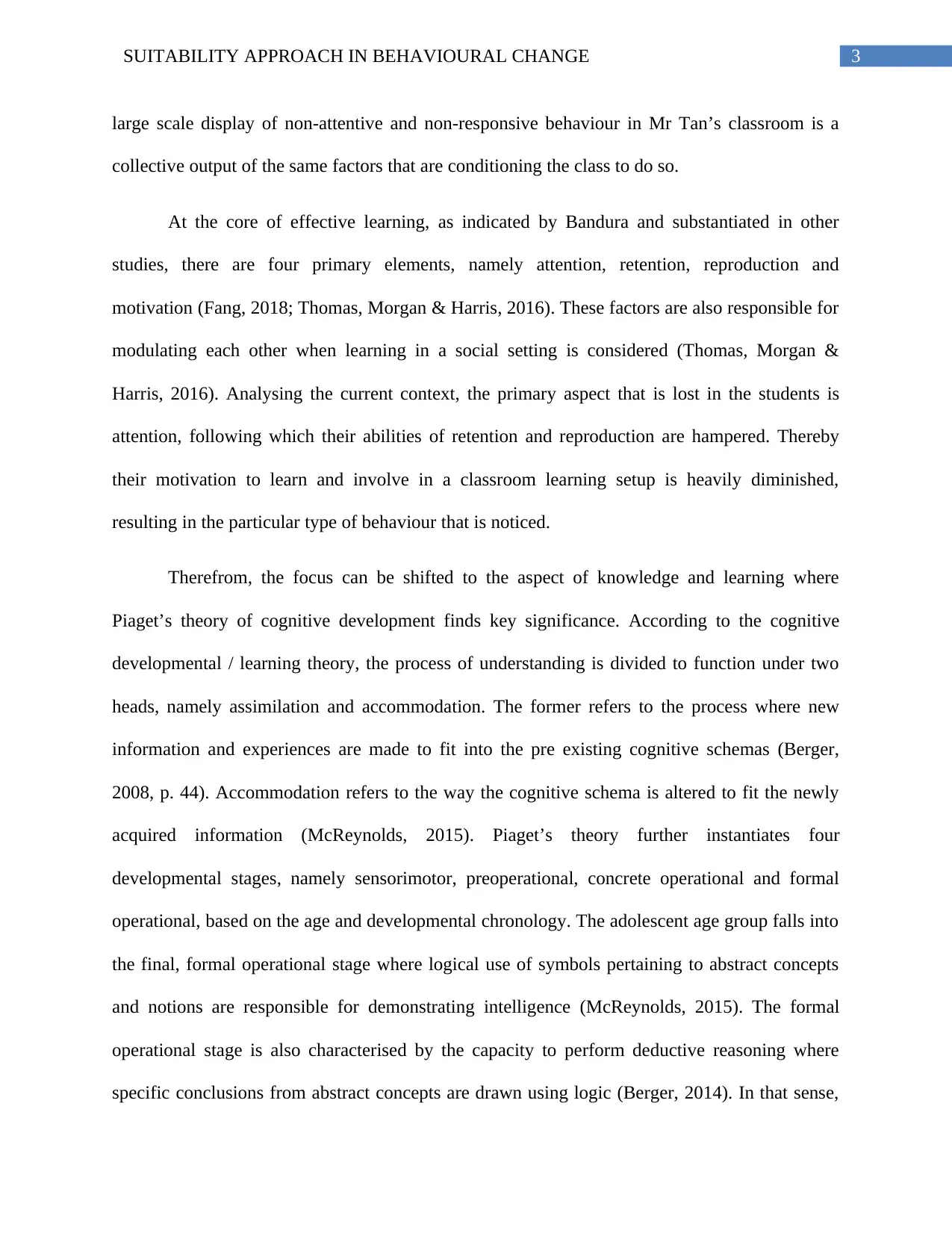
3SUITABILITY APPROACH IN BEHAVIOURAL CHANGE
large scale display of non-attentive and non-responsive behaviour in Mr Tan’s classroom is a
collective output of the same factors that are conditioning the class to do so.
At the core of effective learning, as indicated by Bandura and substantiated in other
studies, there are four primary elements, namely attention, retention, reproduction and
motivation (Fang, 2018; Thomas, Morgan & Harris, 2016). These factors are also responsible for
modulating each other when learning in a social setting is considered (Thomas, Morgan &
Harris, 2016). Analysing the current context, the primary aspect that is lost in the students is
attention, following which their abilities of retention and reproduction are hampered. Thereby
their motivation to learn and involve in a classroom learning setup is heavily diminished,
resulting in the particular type of behaviour that is noticed.
Therefrom, the focus can be shifted to the aspect of knowledge and learning where
Piaget’s theory of cognitive development finds key significance. According to the cognitive
developmental / learning theory, the process of understanding is divided to function under two
heads, namely assimilation and accommodation. The former refers to the process where new
information and experiences are made to fit into the pre existing cognitive schemas (Berger,
2008, p. 44). Accommodation refers to the way the cognitive schema is altered to fit the newly
acquired information (McReynolds, 2015). Piaget’s theory further instantiates four
developmental stages, namely sensorimotor, preoperational, concrete operational and formal
operational, based on the age and developmental chronology. The adolescent age group falls into
the final, formal operational stage where logical use of symbols pertaining to abstract concepts
and notions are responsible for demonstrating intelligence (McReynolds, 2015). The formal
operational stage is also characterised by the capacity to perform deductive reasoning where
specific conclusions from abstract concepts are drawn using logic (Berger, 2014). In that sense,
large scale display of non-attentive and non-responsive behaviour in Mr Tan’s classroom is a
collective output of the same factors that are conditioning the class to do so.
At the core of effective learning, as indicated by Bandura and substantiated in other
studies, there are four primary elements, namely attention, retention, reproduction and
motivation (Fang, 2018; Thomas, Morgan & Harris, 2016). These factors are also responsible for
modulating each other when learning in a social setting is considered (Thomas, Morgan &
Harris, 2016). Analysing the current context, the primary aspect that is lost in the students is
attention, following which their abilities of retention and reproduction are hampered. Thereby
their motivation to learn and involve in a classroom learning setup is heavily diminished,
resulting in the particular type of behaviour that is noticed.
Therefrom, the focus can be shifted to the aspect of knowledge and learning where
Piaget’s theory of cognitive development finds key significance. According to the cognitive
developmental / learning theory, the process of understanding is divided to function under two
heads, namely assimilation and accommodation. The former refers to the process where new
information and experiences are made to fit into the pre existing cognitive schemas (Berger,
2008, p. 44). Accommodation refers to the way the cognitive schema is altered to fit the newly
acquired information (McReynolds, 2015). Piaget’s theory further instantiates four
developmental stages, namely sensorimotor, preoperational, concrete operational and formal
operational, based on the age and developmental chronology. The adolescent age group falls into
the final, formal operational stage where logical use of symbols pertaining to abstract concepts
and notions are responsible for demonstrating intelligence (McReynolds, 2015). The formal
operational stage is also characterised by the capacity to perform deductive reasoning where
specific conclusions from abstract concepts are drawn using logic (Berger, 2014). In that sense,
Secure Best Marks with AI Grader
Need help grading? Try our AI Grader for instant feedback on your assignments.
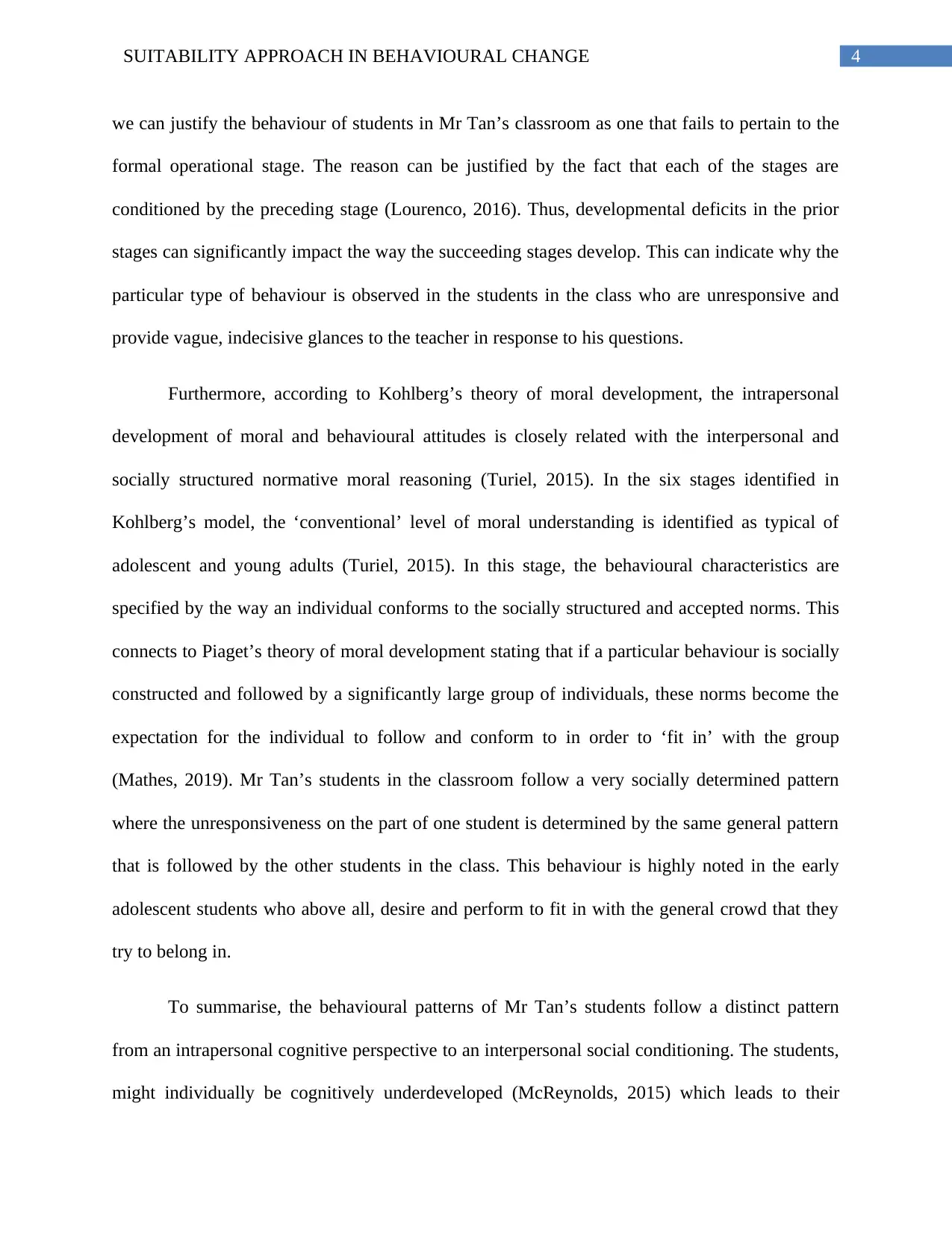
4SUITABILITY APPROACH IN BEHAVIOURAL CHANGE
we can justify the behaviour of students in Mr Tan’s classroom as one that fails to pertain to the
formal operational stage. The reason can be justified by the fact that each of the stages are
conditioned by the preceding stage (Lourenco, 2016). Thus, developmental deficits in the prior
stages can significantly impact the way the succeeding stages develop. This can indicate why the
particular type of behaviour is observed in the students in the class who are unresponsive and
provide vague, indecisive glances to the teacher in response to his questions.
Furthermore, according to Kohlberg’s theory of moral development, the intrapersonal
development of moral and behavioural attitudes is closely related with the interpersonal and
socially structured normative moral reasoning (Turiel, 2015). In the six stages identified in
Kohlberg’s model, the ‘conventional’ level of moral understanding is identified as typical of
adolescent and young adults (Turiel, 2015). In this stage, the behavioural characteristics are
specified by the way an individual conforms to the socially structured and accepted norms. This
connects to Piaget’s theory of moral development stating that if a particular behaviour is socially
constructed and followed by a significantly large group of individuals, these norms become the
expectation for the individual to follow and conform to in order to ‘fit in’ with the group
(Mathes, 2019). Mr Tan’s students in the classroom follow a very socially determined pattern
where the unresponsiveness on the part of one student is determined by the same general pattern
that is followed by the other students in the class. This behaviour is highly noted in the early
adolescent students who above all, desire and perform to fit in with the general crowd that they
try to belong in.
To summarise, the behavioural patterns of Mr Tan’s students follow a distinct pattern
from an intrapersonal cognitive perspective to an interpersonal social conditioning. The students,
might individually be cognitively underdeveloped (McReynolds, 2015) which leads to their
we can justify the behaviour of students in Mr Tan’s classroom as one that fails to pertain to the
formal operational stage. The reason can be justified by the fact that each of the stages are
conditioned by the preceding stage (Lourenco, 2016). Thus, developmental deficits in the prior
stages can significantly impact the way the succeeding stages develop. This can indicate why the
particular type of behaviour is observed in the students in the class who are unresponsive and
provide vague, indecisive glances to the teacher in response to his questions.
Furthermore, according to Kohlberg’s theory of moral development, the intrapersonal
development of moral and behavioural attitudes is closely related with the interpersonal and
socially structured normative moral reasoning (Turiel, 2015). In the six stages identified in
Kohlberg’s model, the ‘conventional’ level of moral understanding is identified as typical of
adolescent and young adults (Turiel, 2015). In this stage, the behavioural characteristics are
specified by the way an individual conforms to the socially structured and accepted norms. This
connects to Piaget’s theory of moral development stating that if a particular behaviour is socially
constructed and followed by a significantly large group of individuals, these norms become the
expectation for the individual to follow and conform to in order to ‘fit in’ with the group
(Mathes, 2019). Mr Tan’s students in the classroom follow a very socially determined pattern
where the unresponsiveness on the part of one student is determined by the same general pattern
that is followed by the other students in the class. This behaviour is highly noted in the early
adolescent students who above all, desire and perform to fit in with the general crowd that they
try to belong in.
To summarise, the behavioural patterns of Mr Tan’s students follow a distinct pattern
from an intrapersonal cognitive perspective to an interpersonal social conditioning. The students,
might individually be cognitively underdeveloped (McReynolds, 2015) which leads to their
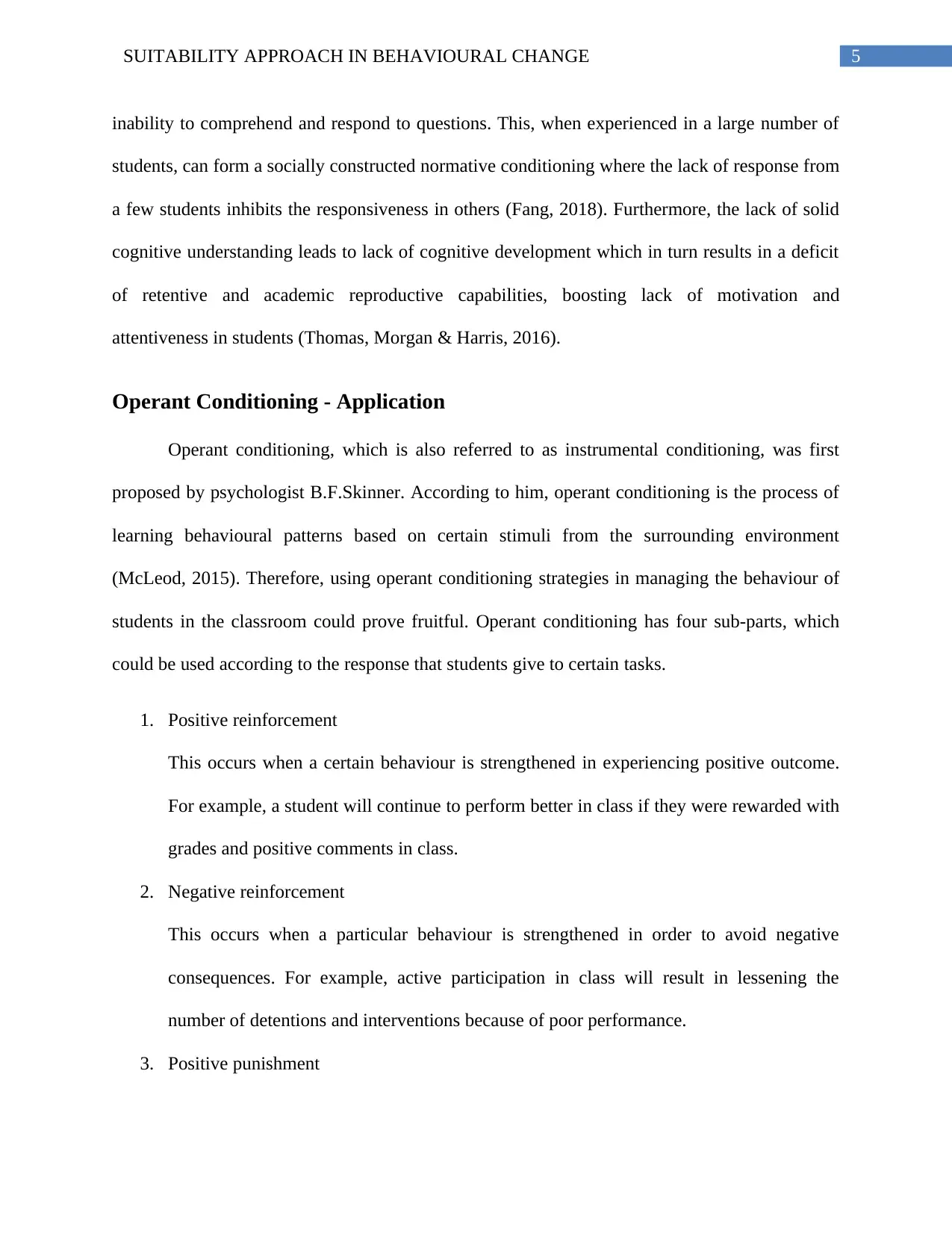
5SUITABILITY APPROACH IN BEHAVIOURAL CHANGE
inability to comprehend and respond to questions. This, when experienced in a large number of
students, can form a socially constructed normative conditioning where the lack of response from
a few students inhibits the responsiveness in others (Fang, 2018). Furthermore, the lack of solid
cognitive understanding leads to lack of cognitive development which in turn results in a deficit
of retentive and academic reproductive capabilities, boosting lack of motivation and
attentiveness in students (Thomas, Morgan & Harris, 2016).
Operant Conditioning - Application
Operant conditioning, which is also referred to as instrumental conditioning, was first
proposed by psychologist B.F.Skinner. According to him, operant conditioning is the process of
learning behavioural patterns based on certain stimuli from the surrounding environment
(McLeod, 2015). Therefore, using operant conditioning strategies in managing the behaviour of
students in the classroom could prove fruitful. Operant conditioning has four sub-parts, which
could be used according to the response that students give to certain tasks.
1. Positive reinforcement
This occurs when a certain behaviour is strengthened in experiencing positive outcome.
For example, a student will continue to perform better in class if they were rewarded with
grades and positive comments in class.
2. Negative reinforcement
This occurs when a particular behaviour is strengthened in order to avoid negative
consequences. For example, active participation in class will result in lessening the
number of detentions and interventions because of poor performance.
3. Positive punishment
inability to comprehend and respond to questions. This, when experienced in a large number of
students, can form a socially constructed normative conditioning where the lack of response from
a few students inhibits the responsiveness in others (Fang, 2018). Furthermore, the lack of solid
cognitive understanding leads to lack of cognitive development which in turn results in a deficit
of retentive and academic reproductive capabilities, boosting lack of motivation and
attentiveness in students (Thomas, Morgan & Harris, 2016).
Operant Conditioning - Application
Operant conditioning, which is also referred to as instrumental conditioning, was first
proposed by psychologist B.F.Skinner. According to him, operant conditioning is the process of
learning behavioural patterns based on certain stimuli from the surrounding environment
(McLeod, 2015). Therefore, using operant conditioning strategies in managing the behaviour of
students in the classroom could prove fruitful. Operant conditioning has four sub-parts, which
could be used according to the response that students give to certain tasks.
1. Positive reinforcement
This occurs when a certain behaviour is strengthened in experiencing positive outcome.
For example, a student will continue to perform better in class if they were rewarded with
grades and positive comments in class.
2. Negative reinforcement
This occurs when a particular behaviour is strengthened in order to avoid negative
consequences. For example, active participation in class will result in lessening the
number of detentions and interventions because of poor performance.
3. Positive punishment
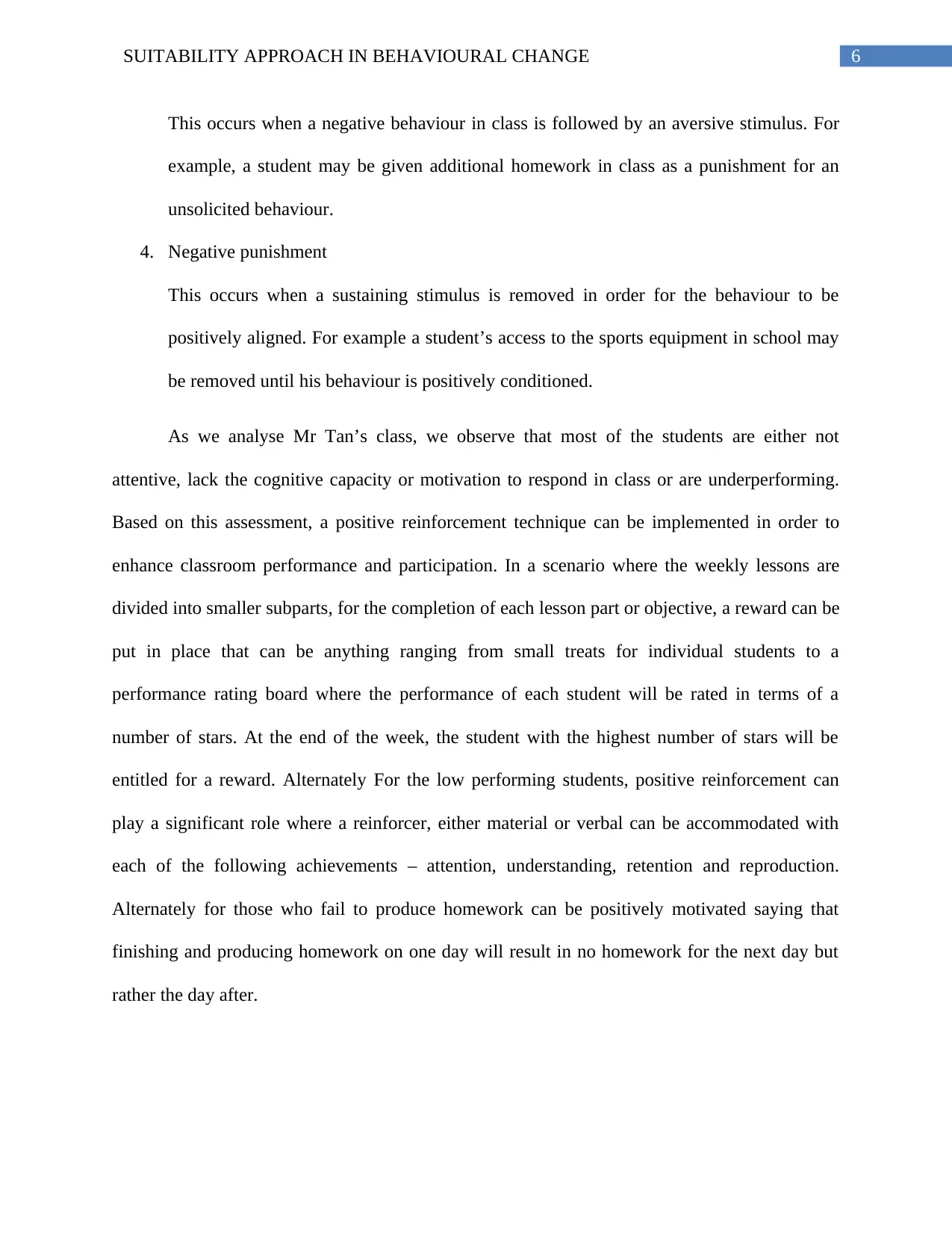
6SUITABILITY APPROACH IN BEHAVIOURAL CHANGE
This occurs when a negative behaviour in class is followed by an aversive stimulus. For
example, a student may be given additional homework in class as a punishment for an
unsolicited behaviour.
4. Negative punishment
This occurs when a sustaining stimulus is removed in order for the behaviour to be
positively aligned. For example a student’s access to the sports equipment in school may
be removed until his behaviour is positively conditioned.
As we analyse Mr Tan’s class, we observe that most of the students are either not
attentive, lack the cognitive capacity or motivation to respond in class or are underperforming.
Based on this assessment, a positive reinforcement technique can be implemented in order to
enhance classroom performance and participation. In a scenario where the weekly lessons are
divided into smaller subparts, for the completion of each lesson part or objective, a reward can be
put in place that can be anything ranging from small treats for individual students to a
performance rating board where the performance of each student will be rated in terms of a
number of stars. At the end of the week, the student with the highest number of stars will be
entitled for a reward. Alternately For the low performing students, positive reinforcement can
play a significant role where a reinforcer, either material or verbal can be accommodated with
each of the following achievements – attention, understanding, retention and reproduction.
Alternately for those who fail to produce homework can be positively motivated saying that
finishing and producing homework on one day will result in no homework for the next day but
rather the day after.
This occurs when a negative behaviour in class is followed by an aversive stimulus. For
example, a student may be given additional homework in class as a punishment for an
unsolicited behaviour.
4. Negative punishment
This occurs when a sustaining stimulus is removed in order for the behaviour to be
positively aligned. For example a student’s access to the sports equipment in school may
be removed until his behaviour is positively conditioned.
As we analyse Mr Tan’s class, we observe that most of the students are either not
attentive, lack the cognitive capacity or motivation to respond in class or are underperforming.
Based on this assessment, a positive reinforcement technique can be implemented in order to
enhance classroom performance and participation. In a scenario where the weekly lessons are
divided into smaller subparts, for the completion of each lesson part or objective, a reward can be
put in place that can be anything ranging from small treats for individual students to a
performance rating board where the performance of each student will be rated in terms of a
number of stars. At the end of the week, the student with the highest number of stars will be
entitled for a reward. Alternately For the low performing students, positive reinforcement can
play a significant role where a reinforcer, either material or verbal can be accommodated with
each of the following achievements – attention, understanding, retention and reproduction.
Alternately for those who fail to produce homework can be positively motivated saying that
finishing and producing homework on one day will result in no homework for the next day but
rather the day after.
Paraphrase This Document
Need a fresh take? Get an instant paraphrase of this document with our AI Paraphraser
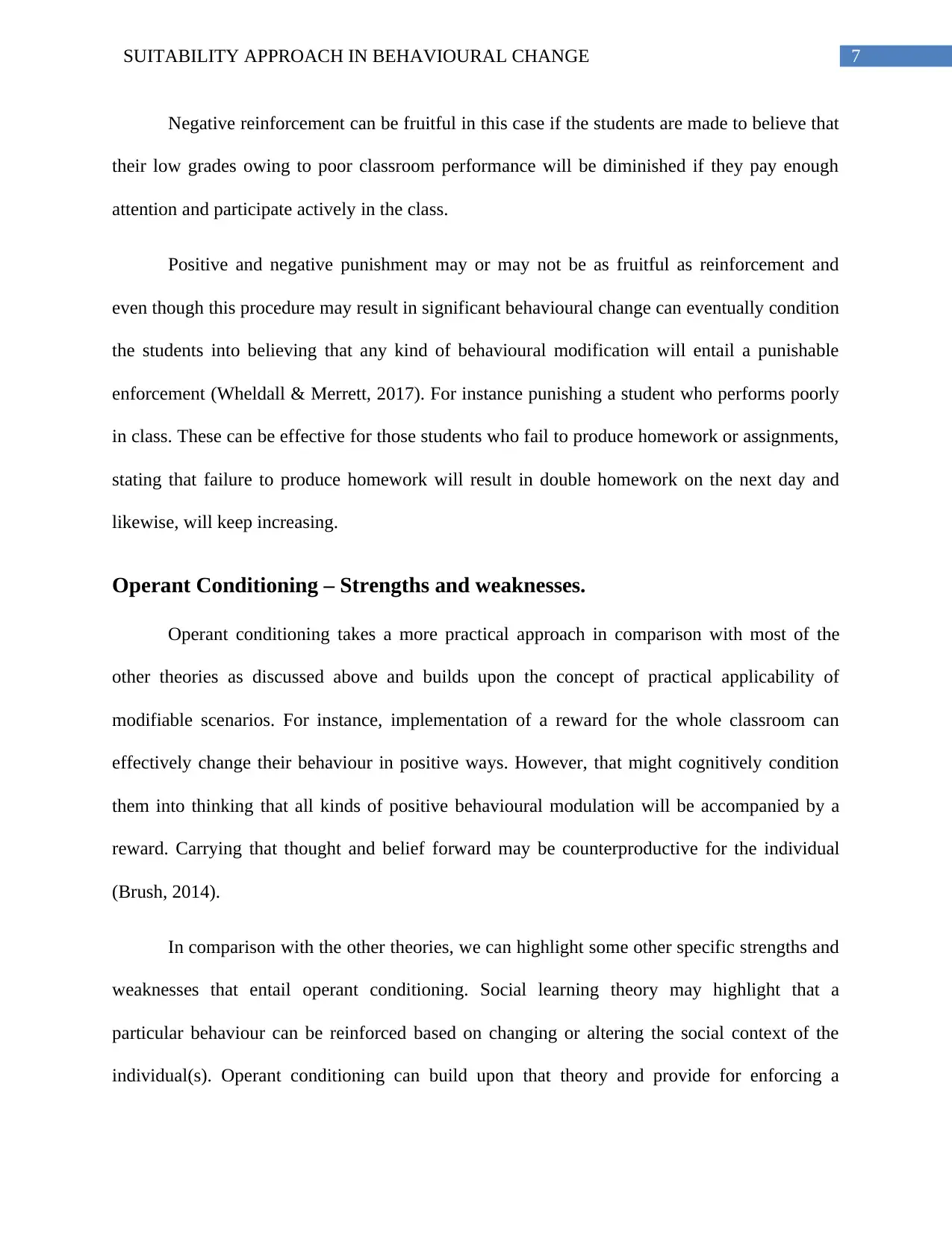
7SUITABILITY APPROACH IN BEHAVIOURAL CHANGE
Negative reinforcement can be fruitful in this case if the students are made to believe that
their low grades owing to poor classroom performance will be diminished if they pay enough
attention and participate actively in the class.
Positive and negative punishment may or may not be as fruitful as reinforcement and
even though this procedure may result in significant behavioural change can eventually condition
the students into believing that any kind of behavioural modification will entail a punishable
enforcement (Wheldall & Merrett, 2017). For instance punishing a student who performs poorly
in class. These can be effective for those students who fail to produce homework or assignments,
stating that failure to produce homework will result in double homework on the next day and
likewise, will keep increasing.
Operant Conditioning – Strengths and weaknesses.
Operant conditioning takes a more practical approach in comparison with most of the
other theories as discussed above and builds upon the concept of practical applicability of
modifiable scenarios. For instance, implementation of a reward for the whole classroom can
effectively change their behaviour in positive ways. However, that might cognitively condition
them into thinking that all kinds of positive behavioural modulation will be accompanied by a
reward. Carrying that thought and belief forward may be counterproductive for the individual
(Brush, 2014).
In comparison with the other theories, we can highlight some other specific strengths and
weaknesses that entail operant conditioning. Social learning theory may highlight that a
particular behaviour can be reinforced based on changing or altering the social context of the
individual(s). Operant conditioning can build upon that theory and provide for enforcing a
Negative reinforcement can be fruitful in this case if the students are made to believe that
their low grades owing to poor classroom performance will be diminished if they pay enough
attention and participate actively in the class.
Positive and negative punishment may or may not be as fruitful as reinforcement and
even though this procedure may result in significant behavioural change can eventually condition
the students into believing that any kind of behavioural modification will entail a punishable
enforcement (Wheldall & Merrett, 2017). For instance punishing a student who performs poorly
in class. These can be effective for those students who fail to produce homework or assignments,
stating that failure to produce homework will result in double homework on the next day and
likewise, will keep increasing.
Operant Conditioning – Strengths and weaknesses.
Operant conditioning takes a more practical approach in comparison with most of the
other theories as discussed above and builds upon the concept of practical applicability of
modifiable scenarios. For instance, implementation of a reward for the whole classroom can
effectively change their behaviour in positive ways. However, that might cognitively condition
them into thinking that all kinds of positive behavioural modulation will be accompanied by a
reward. Carrying that thought and belief forward may be counterproductive for the individual
(Brush, 2014).
In comparison with the other theories, we can highlight some other specific strengths and
weaknesses that entail operant conditioning. Social learning theory may highlight that a
particular behaviour can be reinforced based on changing or altering the social context of the
individual(s). Operant conditioning can build upon that theory and provide for enforcing a
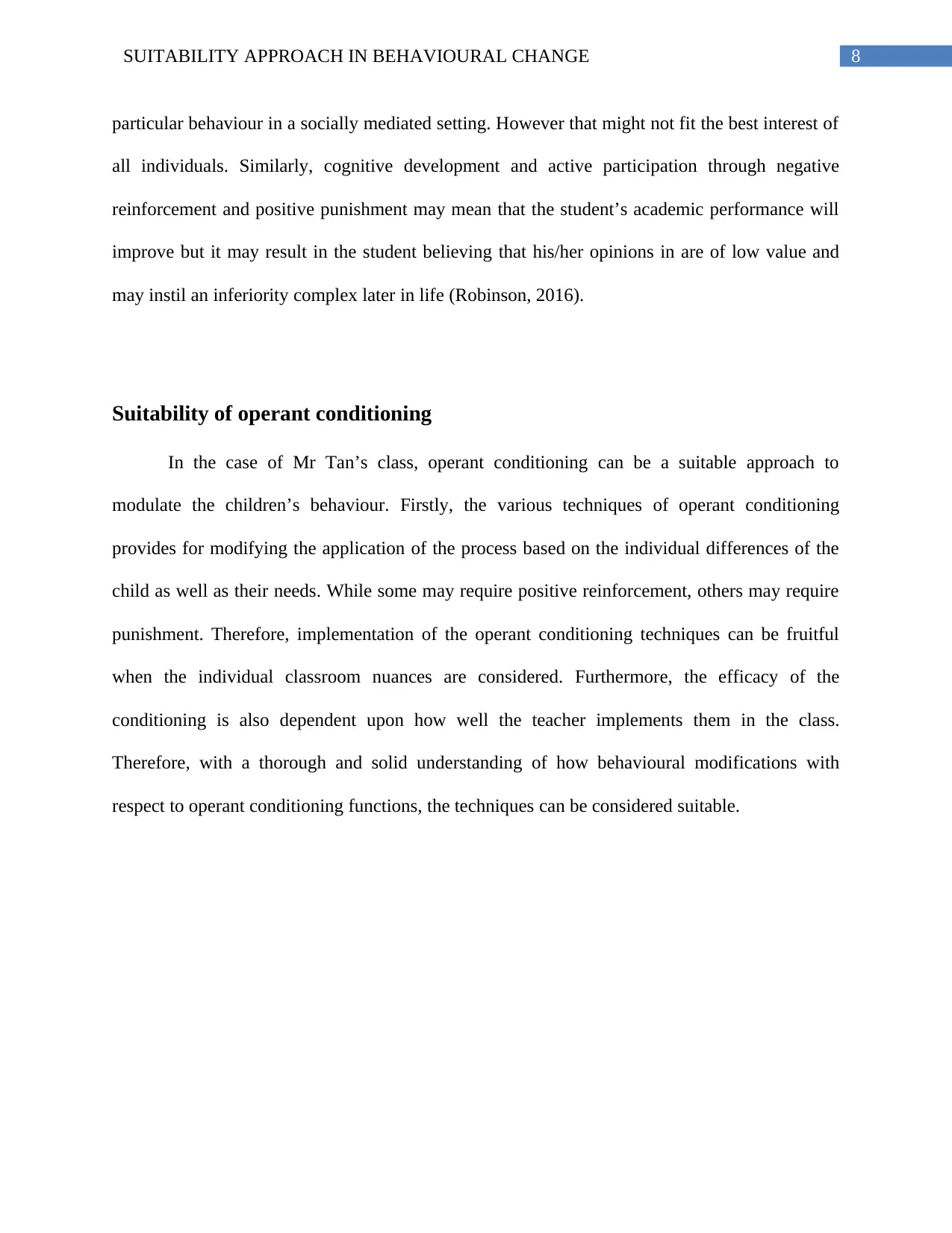
8SUITABILITY APPROACH IN BEHAVIOURAL CHANGE
particular behaviour in a socially mediated setting. However that might not fit the best interest of
all individuals. Similarly, cognitive development and active participation through negative
reinforcement and positive punishment may mean that the student’s academic performance will
improve but it may result in the student believing that his/her opinions in are of low value and
may instil an inferiority complex later in life (Robinson, 2016).
Suitability of operant conditioning
In the case of Mr Tan’s class, operant conditioning can be a suitable approach to
modulate the children’s behaviour. Firstly, the various techniques of operant conditioning
provides for modifying the application of the process based on the individual differences of the
child as well as their needs. While some may require positive reinforcement, others may require
punishment. Therefore, implementation of the operant conditioning techniques can be fruitful
when the individual classroom nuances are considered. Furthermore, the efficacy of the
conditioning is also dependent upon how well the teacher implements them in the class.
Therefore, with a thorough and solid understanding of how behavioural modifications with
respect to operant conditioning functions, the techniques can be considered suitable.
particular behaviour in a socially mediated setting. However that might not fit the best interest of
all individuals. Similarly, cognitive development and active participation through negative
reinforcement and positive punishment may mean that the student’s academic performance will
improve but it may result in the student believing that his/her opinions in are of low value and
may instil an inferiority complex later in life (Robinson, 2016).
Suitability of operant conditioning
In the case of Mr Tan’s class, operant conditioning can be a suitable approach to
modulate the children’s behaviour. Firstly, the various techniques of operant conditioning
provides for modifying the application of the process based on the individual differences of the
child as well as their needs. While some may require positive reinforcement, others may require
punishment. Therefore, implementation of the operant conditioning techniques can be fruitful
when the individual classroom nuances are considered. Furthermore, the efficacy of the
conditioning is also dependent upon how well the teacher implements them in the class.
Therefore, with a thorough and solid understanding of how behavioural modifications with
respect to operant conditioning functions, the techniques can be considered suitable.
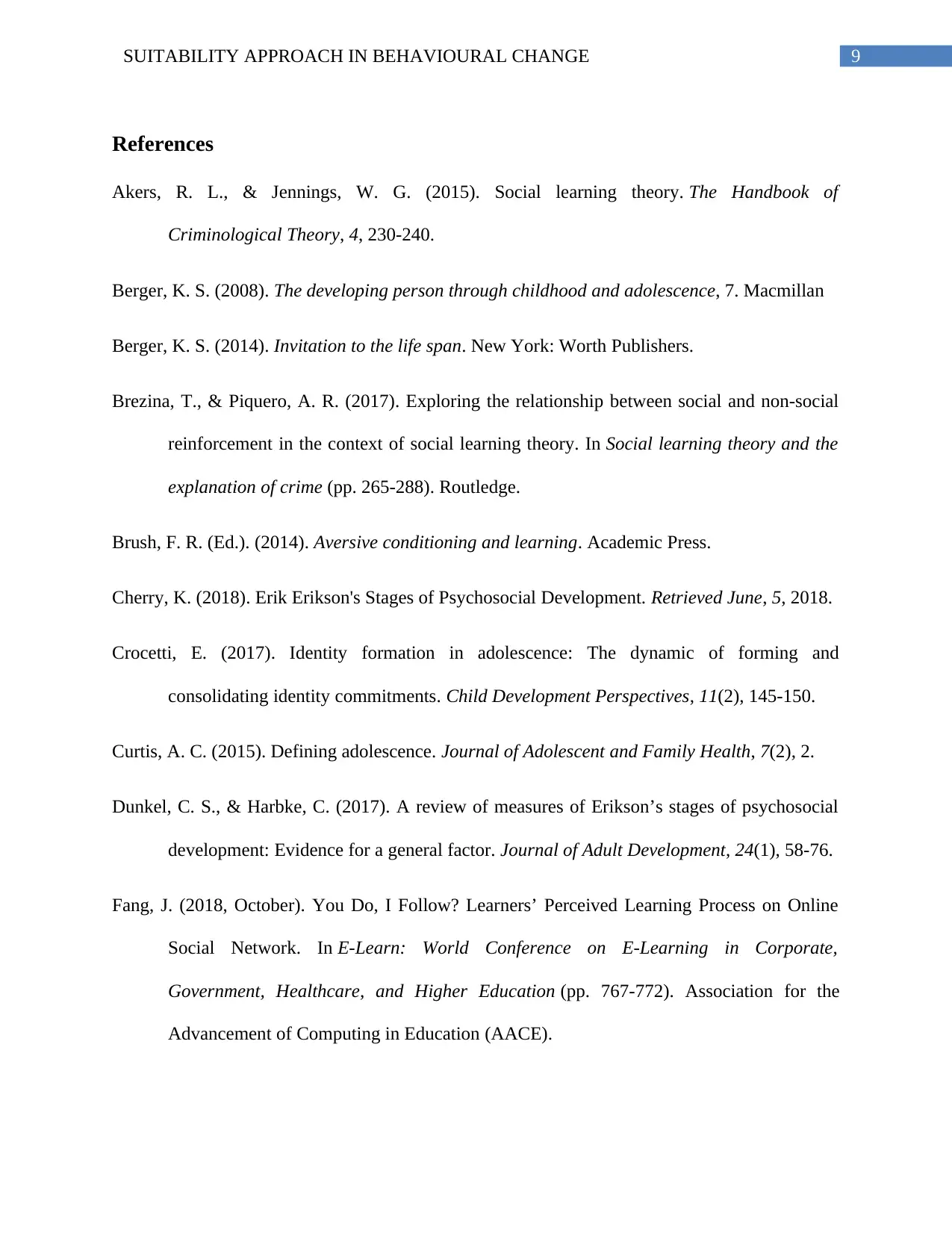
9SUITABILITY APPROACH IN BEHAVIOURAL CHANGE
References
Akers, R. L., & Jennings, W. G. (2015). Social learning theory. The Handbook of
Criminological Theory, 4, 230-240.
Berger, K. S. (2008). The developing person through childhood and adolescence, 7. Macmillan
Berger, K. S. (2014). Invitation to the life span. New York: Worth Publishers.
Brezina, T., & Piquero, A. R. (2017). Exploring the relationship between social and non-social
reinforcement in the context of social learning theory. In Social learning theory and the
explanation of crime (pp. 265-288). Routledge.
Brush, F. R. (Ed.). (2014). Aversive conditioning and learning. Academic Press.
Cherry, K. (2018). Erik Erikson's Stages of Psychosocial Development. Retrieved June, 5, 2018.
Crocetti, E. (2017). Identity formation in adolescence: The dynamic of forming and
consolidating identity commitments. Child Development Perspectives, 11(2), 145-150.
Curtis, A. C. (2015). Defining adolescence. Journal of Adolescent and Family Health, 7(2), 2.
Dunkel, C. S., & Harbke, C. (2017). A review of measures of Erikson’s stages of psychosocial
development: Evidence for a general factor. Journal of Adult Development, 24(1), 58-76.
Fang, J. (2018, October). You Do, I Follow? Learners’ Perceived Learning Process on Online
Social Network. In E-Learn: World Conference on E-Learning in Corporate,
Government, Healthcare, and Higher Education (pp. 767-772). Association for the
Advancement of Computing in Education (AACE).
References
Akers, R. L., & Jennings, W. G. (2015). Social learning theory. The Handbook of
Criminological Theory, 4, 230-240.
Berger, K. S. (2008). The developing person through childhood and adolescence, 7. Macmillan
Berger, K. S. (2014). Invitation to the life span. New York: Worth Publishers.
Brezina, T., & Piquero, A. R. (2017). Exploring the relationship between social and non-social
reinforcement in the context of social learning theory. In Social learning theory and the
explanation of crime (pp. 265-288). Routledge.
Brush, F. R. (Ed.). (2014). Aversive conditioning and learning. Academic Press.
Cherry, K. (2018). Erik Erikson's Stages of Psychosocial Development. Retrieved June, 5, 2018.
Crocetti, E. (2017). Identity formation in adolescence: The dynamic of forming and
consolidating identity commitments. Child Development Perspectives, 11(2), 145-150.
Curtis, A. C. (2015). Defining adolescence. Journal of Adolescent and Family Health, 7(2), 2.
Dunkel, C. S., & Harbke, C. (2017). A review of measures of Erikson’s stages of psychosocial
development: Evidence for a general factor. Journal of Adult Development, 24(1), 58-76.
Fang, J. (2018, October). You Do, I Follow? Learners’ Perceived Learning Process on Online
Social Network. In E-Learn: World Conference on E-Learning in Corporate,
Government, Healthcare, and Higher Education (pp. 767-772). Association for the
Advancement of Computing in Education (AACE).
Secure Best Marks with AI Grader
Need help grading? Try our AI Grader for instant feedback on your assignments.
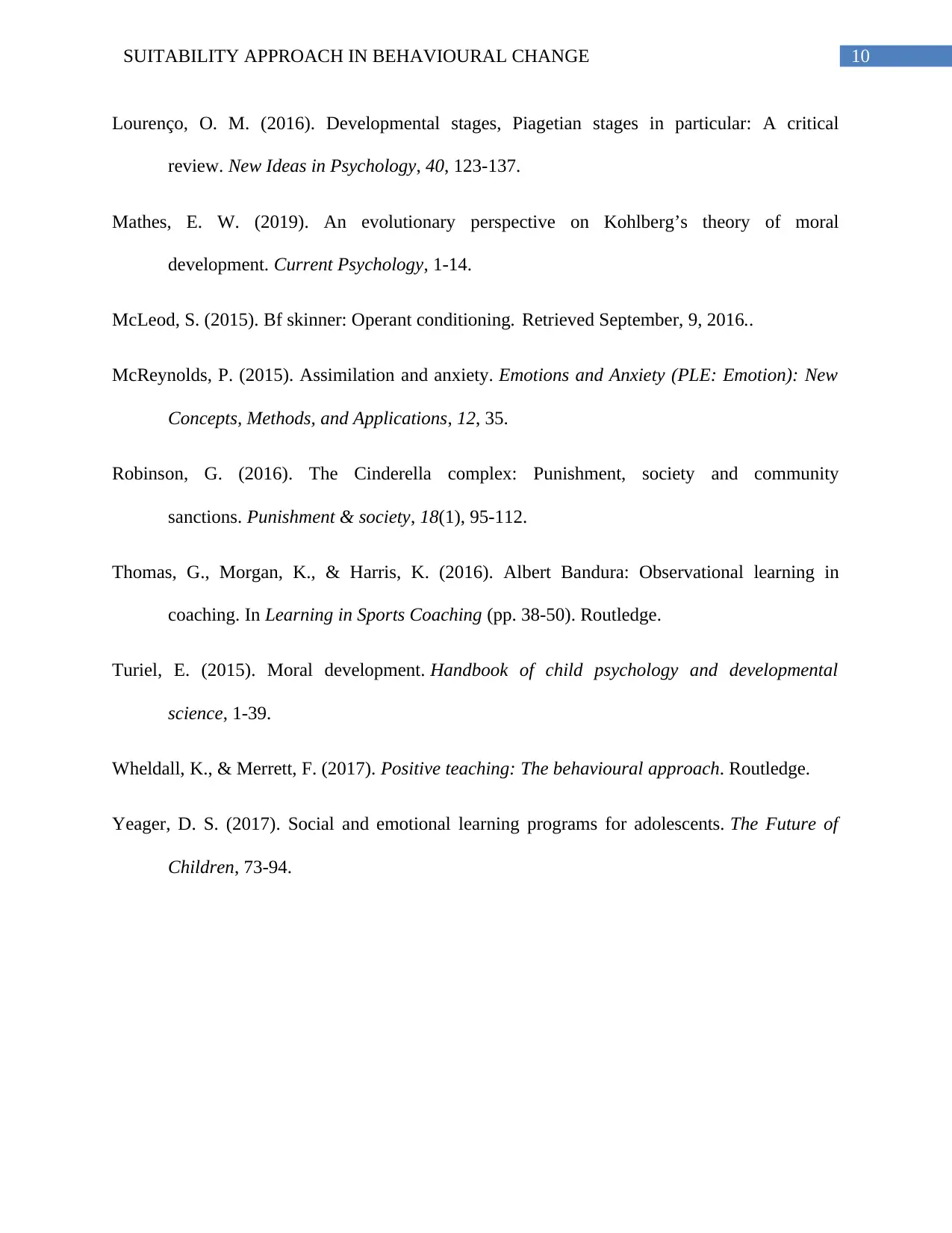
10SUITABILITY APPROACH IN BEHAVIOURAL CHANGE
Lourenço, O. M. (2016). Developmental stages, Piagetian stages in particular: A critical
review. New Ideas in Psychology, 40, 123-137.
Mathes, E. W. (2019). An evolutionary perspective on Kohlberg’s theory of moral
development. Current Psychology, 1-14.
McLeod, S. (2015). Bf skinner: Operant conditioning. Retrieved September, 9, 2016..
McReynolds, P. (2015). Assimilation and anxiety. Emotions and Anxiety (PLE: Emotion): New
Concepts, Methods, and Applications, 12, 35.
Robinson, G. (2016). The Cinderella complex: Punishment, society and community
sanctions. Punishment & society, 18(1), 95-112.
Thomas, G., Morgan, K., & Harris, K. (2016). Albert Bandura: Observational learning in
coaching. In Learning in Sports Coaching (pp. 38-50). Routledge.
Turiel, E. (2015). Moral development. Handbook of child psychology and developmental
science, 1-39.
Wheldall, K., & Merrett, F. (2017). Positive teaching: The behavioural approach. Routledge.
Yeager, D. S. (2017). Social and emotional learning programs for adolescents. The Future of
Children, 73-94.
Lourenço, O. M. (2016). Developmental stages, Piagetian stages in particular: A critical
review. New Ideas in Psychology, 40, 123-137.
Mathes, E. W. (2019). An evolutionary perspective on Kohlberg’s theory of moral
development. Current Psychology, 1-14.
McLeod, S. (2015). Bf skinner: Operant conditioning. Retrieved September, 9, 2016..
McReynolds, P. (2015). Assimilation and anxiety. Emotions and Anxiety (PLE: Emotion): New
Concepts, Methods, and Applications, 12, 35.
Robinson, G. (2016). The Cinderella complex: Punishment, society and community
sanctions. Punishment & society, 18(1), 95-112.
Thomas, G., Morgan, K., & Harris, K. (2016). Albert Bandura: Observational learning in
coaching. In Learning in Sports Coaching (pp. 38-50). Routledge.
Turiel, E. (2015). Moral development. Handbook of child psychology and developmental
science, 1-39.
Wheldall, K., & Merrett, F. (2017). Positive teaching: The behavioural approach. Routledge.
Yeager, D. S. (2017). Social and emotional learning programs for adolescents. The Future of
Children, 73-94.
1 out of 11
Related Documents
Your All-in-One AI-Powered Toolkit for Academic Success.
+13062052269
info@desklib.com
Available 24*7 on WhatsApp / Email
![[object Object]](/_next/static/media/star-bottom.7253800d.svg)
Unlock your academic potential
© 2024 | Zucol Services PVT LTD | All rights reserved.





